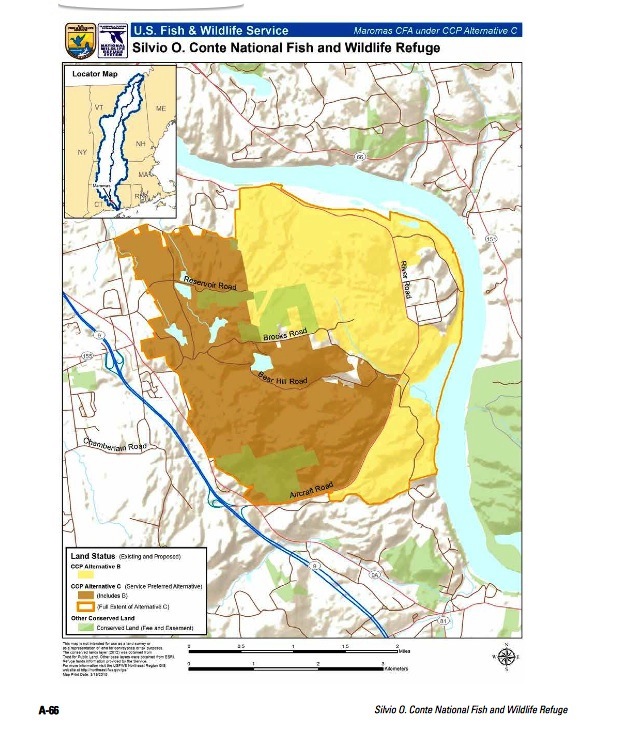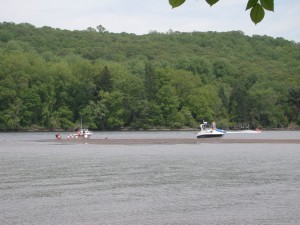Silvio O. Conte Long-Range Plan: Speak Now For Land, River, Species
Sturgeon. Bald Eagles. Amphibians. Insects. Migratory species. Incredible geology and access to major population centers. A natural wonder, the Connecticut River watershed involves four states and is a wealth of biodiversity.

Acipenser oxyrhynchus – Atlantic sturgeon – by Duane Raver, U.S. Fish and Wildlife Service. One of the oldest fish species in the world. Range is from New Brunswick, Canada, south including the Connecticut River, to the eastern coast of Florida. Weights of up to 800 pounds, lengths of 12 feet and a life span of 50 to 75 years have been reported. Original art is kept at NCTC museum.
Which of the four options do you think will work best for a region and the diverse forms of life (including humans) that live in or are seasonal visitors to the Connecticut River watershed that stretches from Vermont and New Hampshire south through Massachusetts and Connecticut?
Once decisions are final, the plan will guide management of the refuge for a period of 15 years. Public review and comment is open through Monday, Nov. 16, 2015.
Time is running short to comment on the U.S. Fish and Wildlife Service (USFWS) draft comprehensive plan and environmental impact statement for the Silvio O. Conte National Fish and Wildlife Refuge, the nation’s first watershed-based, landscape-scale refuge which conserves more than 36,000 acres throughout the 7.2 million-acre watershed.
Those who live in the region (or love visiting), from city and town planners to government leaders, land and business owners, anyone involved in transportation and tourism, fishing, hunting, land access, trails, outdoor recreation, birdwatching, boating – should pay attention.

Silvio O. Conte, a man of integrity and many accomplishments that included U.S. Congressman, machinist; lawyer. Collection of the U.S. House of Representatives.
Established in 1997 to “conserve, protect and enhance the abundance and diversity of native plant, fish and wildlife species and the ecosystems throughout the Connecticut River watershed, the refuge is named for the late Silvio O. Conte, a longtime member of the U.S. House of Representatives for Massachusetts who worked tirelessly to preserve and protect the environment.
Submit comments online now about this comprehensive draft plan that outlines four options: Electronically via the Federal eRulemaking Portal at: www.regulations.gov. In the “Search” box, commenters will enter the docket number (FWS-R5-NWRS-2015-0036) for this project. Comments can be submitted by clicking on “Comment Now!” You can add attachments to a comment. All comments will be posted to http://www.regulations.gov and will be available for public viewing. Note: This generally means that any personal information provided will be posted with a comment. In November, four formal public hearings provided an opportunity for individuals to present their comments, the last being Nov. 12.
The entire plan is worth reading as the richness of information includes a deep and detailed report about species which live in or are migratory to the proposed land acquisitions of four states. Geology and special areas of concerns can shed light on familiar trails and add to interest on any outing.
Consider this from the report: “In its entirety, the watershed encompasses an area of more than 11,000 square miles and contains nearly 400 towns and cities. … The river itself provided a source of energy to power mills, factories, and entire communities, irrigation water for working farmlands, and a means of transportation for the watershed’s people and goods. The regional economy has evolved from the original agricultural colonists and small goods traders, to robust manufacturing production and supporting commodity extraction industries, to relying more on the services sector and travel and tourism spending.
“Currently, large urban centers within the southern counties of the Watershed serve as hubs to the greater New York City area with many residents employed in the service industry. Counties near the northern headwaters continue to promote a more rural way of life and are still highly dependent on manufacturing jobs. Many of the towns within the Watershed are attempting to capture more of the valuable tourism market by hosting annual festivals and cultural events that attract crowds from beyond the community borders. Many of these events are centered on the historic, cultural, and economic makeup of the region. Area farmers and artisans are once again finding local markets for their goods, while catering to buyers and their overall experience. Agritourism seems to be expanding at a considerable rate, with each state in the watershed now having a website and interactive map just for these enterprises.”
For Connecticut this includes: Proposed, Farmington River Conservation Focus Area (CFA); Maromas CFA; Pyquag CFA; Salmon Brook CFA; Salmon River CFA (existing refuge division); Scantic CFA (proposed); Whalebone Cove CFA (existing refuge division); Dead Man’s Swamp (existing refuge unit); Roger Tory Peterson (existing refuge unit); Friends of Conte Refuge.
Maromas CFA is a “large, forested upland area bounded by the mainstem of Connecticut River on two sides. Its proximity to Middletown and other urbanized areas provides an important opportunity to connect with urban audiences and contribute to the Service’s Urban Refuge initiative. The proposed CFA is also directly across the Connecticut River from the refuge’s existing Salmon River Division. Conserving these two divisions will help provide connectivity on both sides of the river. The Maromas CFA provides a connection between two undeveloped forest corridors located in the Lower Connecticut River and, further north, along the Bolton Range. These corridors have been recognized for their lack of development, and their importance to neotropical migrants (Comins 2013, personnel communication). The Bolten Range corridor extends into Massachusetts, and provides forest bird nesting habitat. Other existing conserved lands near the Maromas CFA include the Seven Falls, George Dudley Seymour, and Hurd State Parks.”
To anyone in the region who loves the outdoor, this rugged stretch of woods, rock, river feels like a wilderness oasis despite proximity to small cities and towns.

An overview map of Maromas on the Connecticut River is linked to the comprehensive plan proposed for not only this area, but also the Farmington River and three other states in the watershed.
What public use opportunities would likely be a priority on refuge lands within the proposed CFA? “We would focus on providing opportunities for the six priority, wildlife-dependent recreational uses: hunting, fishing, wildlife observation and photography, interpretation, and environmental education.”
Here are some excerpts on just one of the targeted places, Maromas which is located south of Middletown to Haddam.
There are “10 priority refuge resources of concern; specifically, terrestrial and aquatic species that may rely upon the diverse habitats in this CFA. There are also habitat types that are not being managed for a particular species, but are important for their contribution to Biological Integrity Diversity and Environmental Health (BIDEH) of the landscape.”
The Connecticut River is “important migratory and overwintering habitat for shortnose sturgeon, a federally listed species. American eel, a species petitioned for federal listing, spends the majority of its young life in the freshwater systems of this CFA.”
The Connecticut River watershed is a major migration corridor. The lower portion of the watershed (Connecticut and Massachusetts) receives higher use by migrants, with this use concentrated in habitats along the Connecticut River main stem (Smith College 2006). The Maromas CFA is situated on the Connecticut River, and the forested habitat and wetlands provide important stopover and breeding habitat for land birds.
The Maromas CFA provides a connection between two undeveloped forest corridors located in the Lower Connecticut River and, further north, along the Bolton Range. These corridors have been recognized for their lack of development, and their importance to neotropical migrants (Comins 2013, personnel communication). The Bolten Range corridor extends into Massachusetts, and provides forest bird nesting habitat.
“…the Maromas CFA includes wood thrush and Louisiana waterthrush. This CFA is located within their core breeding range, and the contiguous forests provide breeding habitat for these and other forest nesting birds, many of which are priority conservation concern species. Bald eagles are also a species for this CFA. Habitats support nesting, migrating and wintering bald eagle populations.”
Here is what is included in the draft proposal: Chapter 1: An overview of why the refuge needs a comprehensive conservation plan (CCP) and provides background on the refuge’s establishment history and its purposes, vision, and goals. Chapter 2: The Planning Process describes the planning process, the laws and service policies that guide our planning, and summarizes the public and partner issues, opportunities, and concerns we addressed in the draft CCP. Chapter 3: Affected Environment gives an overview of the Connecticut River watershed and the existing refuge’s natural and socioeconomic environments including: air quality, water quality, wildlife, fish, plant, and habitats, and historical and archaeological resources. It also describes refuge administration and existing public use opportunities on refuge lands.
Chapter 4: Alternatives – four alternative scenarios for managing the refuge: Alternative A–Continuing Current Management; Alternative B–Consolidated Stewardship; Alternative C–Enhanced Conservation Connections and Partnerships (the Service’s Preferred Alternative); and Alternative D–Reduced Management with Emphasis on Backcountry Recreation. Note: Alternative C seeks to expand the refuge by 197,296 acres – and is the preferred option of the U.S. Fish and Wildlife Service. The table at the end of chapter 4 compares and contrasts some of the major actions proposed under the four alternatives. Appendix A is the companion to chapter 4 and focuses on more specific sub-objectives and strategies for managing existing and proposed refuge lands. Chapter 5: Environmental Consequences analyzes the anticipated beneficial and adverse impacts from implementing the four different alternatives. The table at the end of chapter 5 summarizes and compares the impacts of the actions proposed under the four alternatives. Chapter 6: Coordination and Consultation lists public and partner meetings we attended or held during the planning process. Chapter 7: List of Preparers lists all of the Service, state, and other partner personnel who worked on the plan. Bibliography lists all of the literature cited for the chapters. Glossary, Acronyms, and Species Scientific Names defines technical terms, lists the scientific names for all the species mentioned, and defines the acronyms used in the chapters.
Appendix A: Resources Overview and Management Direction for Conservation Focus Areas and Refuge Units describes our proposed management actions on existing refuge lands (divisions and units) and where we propose future refuge acquisitions (CFAs). Appendix A takes the broad, watershed level goals and objectives from chapter 4 and steps them down more specifically for refuge lands. This appendix is focused on our proposals under Alternative C (Service-preferred alternative), but is also relevant to refuge lands under alternative B. This appendix is organized by alphabetically by state. Appendix B: Process for Establishing Priority Refuge Resources of Concern describes how we identified refuge species and habitat priorities. Appendix C: Land Protection Plan provides detailed information on the proposed refuge expansion under alternative C. Appendix D: Findings of Appropriateness and Compatibility Determinations explains which public uses we propose to allow and not allow on existing and proposed refuge lands under alternative C. Appendix E: Wilderness Review evaluates existing refuge lands for their potential for inclusion in the National Wilderness Preservation System. At this time, we do not recommend any refuge lands for wilderness designation. Appendix F: Wild and Scenic Rivers Review describes river segments in existing and proposed refuge lands and the process for evaluating their eligibility as National Wild and Scenic Rivers. At this time, we recommend working with partners to evaluate entire rivers, beyond just the segments of rivers on existing and proposed refuge lands. Appendix G: Refuge Operations Needs System and Service Asset Maintenance Management System reflects staffing, operations, and maintenance needs and costs for alternative C. Appendix H: Staffing Charts depicts the current and proposed staffing under each of the alternatives. Appendix I: U.S. Geological Survey Report: Economic Impacts of Current and Proposed Management Alternatives describes the current regional economic setting. It also analyzes and compares the projected socioeconomic impacts of implementing the four alternatives.
Appendix J: Forest Management Guidelines provides additional details on the desired future condition of refuge forests, the specific forest management techniques we propose to use to actively manage refuge forests, and provides a glossary of forestry terms. Appendix K: Silvio O. Conte National Fish and Wildlife Refuge Act of 1991 is the full-text of the refuge’s establishing legislation. Appendix L: Fire Management Program Guidance outlines guidance for fire management, explains the fire management planning process, and describes the current fire management program at the refuge. Appendix M: Conservation Plans and Initiatives Guiding the Development of the CCP lists and describes the conservation plans and initiatives we use to develop the CCP, including national and regional bird plans, state wildlife action plans, recovery plans for federally listed species, and regional recreation plans. Appendix N: List of partnerships highlights the extent and importance of the partnership network in the watershed and lists some of the refuge’s important partners, including government agencies, nonprofits, recreational and environmental educational organizations, academic institutions, and refuge friends groups. There is also a Frequently Asked Questions about Conte NFWR Land Acquisition section. For other background information and maps, see this link to a PDF draft about the scope of what is proposed.

